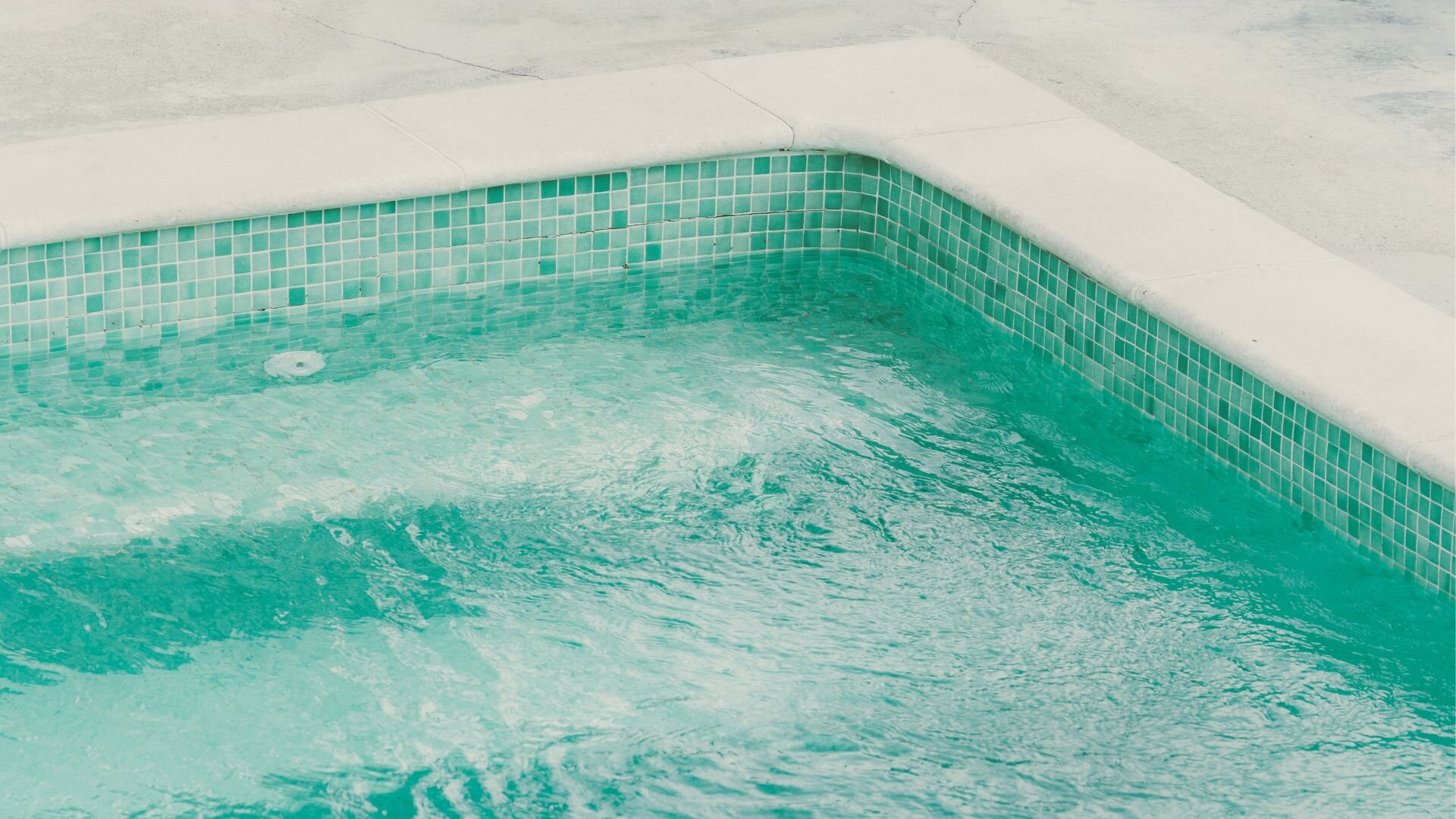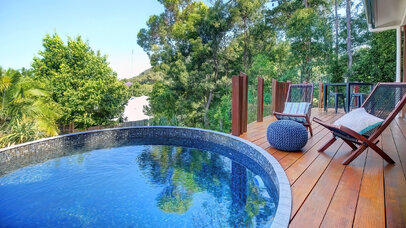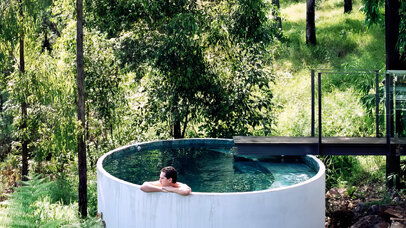A plunge pool, also known as a dipping pool, is a small recreational pool designed for cooling off or relaxation. Plunge pools are typically between 8 and 15 feet in diameter and under 4 feet deep, optimised for sitting partially submerged.
When installing a new plunge pool, one of the biggest decisions is whether to locate it indoors or outdoors. Each option has advantages and disadvantages depending on your climate, property, lifestyle and priorities.
Key factors to weigh include usage, privacy, integration with your home, costs, maintenance and seasonality. Carefully assessing these elements will help determine the optimal location to install your plunge pool for maximum enjoyment. This guide breaks down the pros and cons of indoor vs. outdoor plunge pools to help inform this important decision.
Pros of an Indoor Plunge Pool

Installing your plunge pool indoors provides several key advantages. You’ll enjoy full privacy in a protected, climate-controlled environment safe from outdoor weather and elements. An indoor location allows for comfortable year-round use regardless of season or temperature.
Positioning the pool inside gives shelter from rain, wind, pollen, dirt and other exterior conditions that could limit time spent swimming or increase maintenance needs. The enclosed space also provides seclusion from neighbours and passersby.
An indoor plunge pool will not take up existing outdoor living areas or compete for valuable yard space. The interior spot can be strategically selected to optimise home flow and circulation patterns. Unlike larger pools, a compact plunge pool can fit into many indoor areas like a basement, spare room or converted garage.
The indoor area allows the pool to be integrated into overall home design and decor for a customised oasis. Surrounding it with plants, lighting, tiles, or cabinetry creates a spa-like retreat right inside your home. An indoor pool also adds a unique household amenity.
Cons of an Indoor Plunge Pool
While installing your plunge pool indoors has many advantages, there are also some potential drawbacks to consider. A major downside is increased humidity and moisture levels inside your home from the pool water evaporating. This elevated dampness in the air can promote mould and mildew growth on walls, floors and ceilings if proper ventilation is not installed and maintained. Respiratory issues can result from high indoor humidity as well.
Proper waterproofing of the room housing the pool is critical to prevent leaks and water damage. Adequate drainage for splash overflow will also need to be built in. The costs of these moisture protection measures, as well as heating and dehumidifying equipment plus required ventilation, often make an indoor pool installation significantly pricier compared to outdoor.
The pump, filter and heating equipment may generate noticeable noise in an interior space. The placement of the machinery as far from living areas as possible is key to comfort. However, the sound echoes easily indoors compared to open exterior areas.
Limited room sizes and configurations will restrict the maximum dimensions and layouts available for an indoor plunge pool installation. An outdoor pool has more flexibility in shape and scale.
Pros of an Outdoor Plunge Pool

Installing your plunge pool outdoors provides several advantages, including enjoying natural sunlight and fresh air while soaking in the pool. Positioning the pool in your backyard or patio creates opportunities to fully experience the sights, sounds and scents of your surrounding garden and landscape. You can take in blooming flowers, green trees, chirping birds and other elements of the great outdoors from inside the pool.
Outdoor installation typically allows more flexibility in the maximum shape and dimensions of your plunge pool compared to indoor spaces. Customising the pool outline and contours is easier outside, where there are fewer space constraints. This freedom of design allows better integration with the aesthetics and features of your yard.
Building a plunge pool outdoors often has lower upfront installation costs than interior options since moisture mitigation, ventilation, humidity control, and other considerations are less complex. Minimal retrofitting of your living areas is needed as well.
Complementary amenities like water features, fire pits, sun shelves and lounging areas can be seamlessly incorporated around an outdoor plunge pool. You can also build fantastic views into the setting through thoughtful pool placement.
Cons of an Outdoor Plunge Pool
While an outdoor plunge pool enjoys many advantages, there are also some potential downsides to consider. Locating the pool outside will expose it to elements like rain, heat, falling leaves, pollen and dirt. This can limit time spent enjoying the pool and increase cleaning and chemical balancing maintenance needs.
An outdoor pool’s usage is restricted primarily to spring, summer and fall. You may only get a few months of swimming time annually. Heating the pool sufficiently to allow cold seasons use can be prohibitively expensive for outdoor installations.
There is less privacy than indoor pools, with neighbours, passersby and other community members potentially within sight or earshot. Noise from pool pumps and filtration systems may irritate nearby residents. Strategic fencing, plant screening, and equipment placement can help mitigate outdoor sound and visibility issues.
Routine care and upkeep of the outdoor space around the plunge pool are required. Landscaping, such as lawn mowing, trimming vegetation, and leaf removal, is ongoing. The pool itself will need regular cleaning, chemical balancing and maintenance derived from its exposure to the elements.
Inclement weather like heavy rain, extreme heat, or high winds may prevent swimming on any given day, depending on local conditions. Seasonal factors limit the number of ideal outdoor pool days annually.
What Else Should You Think About When Installing A Plunge Pool?

Climate and Seasons
Take into account your local climate patterns and seasonal weather. An outdoor pool’s usage is limited to spring, summer and fall. Indoor pools allow comfortable swimming year-round by easily regulating water temperature.
Noise Restrictions and Neighbours
Thoroughly evaluate noise ordinances in your community and the proximity of neighbours when weighing pool equipment’s sound impact. Outdoor pool pumps and filtration systems may require acoustic masking using careful placement or sound barriers.
Privacy Preferences
Assess your desired level of privacy from neighbours, passersby or other community members. Indoor pools offer more complete visual and audio seclusion. Outdoor pools can leverage creative screening using proper fencing, wall placements, or plantings around the perimeter.
Integration with Landscape
Consider views from the pool and how they can complement overall landscape design or plantings. Outdoor plunge pools provide more seamless potential to integrate with gardens, patios, water features and outdoor living areas.
Home Value Boost
While both pool types increase home value, indoor pools may raise resale potential more for buyers specifically wanting a year-round backyard oasis. But outdoor pools also boost widespread buyer appeal.
Usage Purposes
Factors in planned exercise use include relaxation, family time, or entertainment. Different primary purposes may dictate optimal sizes, depths, accessories, decks, and seating options.
Frequency of Use
Frequent swimmers may prefer easy year-round indoor pool access. Occasional users may be fine with seasonal outdoor limitations.
Budget and Operating Costs
Indoor pools often have higher upfront installation expenses but can have lower seasonal operating costs. Carefully calculate long-term budgets.
Available Space
Thoroughly evaluate your property’s indoor vs. outdoor space options for maximising pool size potential. Outdoor locations typically allow larger plunge pools.
Professional Tips for Choosing Location
When planning a plunge pool installation, it’s essential to consult an experienced pool designer early in the process. A professional can help you review all your options and identify the best location for your pool based on a thorough site analysis. They have the expertise to anticipate and avoid potential issues, such as moisture damage risks, construction challenges, and equipment needs.
It’s also important to look at the potential impact on your home’s resale value. While any pool can add value, indoor pools may increase home prices more in certain markets by extending the swimming season.
However, indoor pools come with specific humidity and moisture management demands that must be addressed to prevent problems. Proper ventilation, dehumidification, waterproofing, and drainage are crucial for maintaining a healthy indoor pool environment.
When deciding on equipment placement, ensure that there is adequate access for maintenance and repairs. Plan for easy access doors and clear routes for equipment replacement to avoid future hassles. Additionally, check local building codes, permitting laws, and homeowner association rules before finalising the pool’s location, as both indoor and outdoor pools may face specific restrictions or requirements.
Finally, take the time to visualise the pool installed in each space you’re considering. Imagine yourself using the pool in each location and assess whether it will meet your needs and expectations. Mentally walk through various use cases to determine the best spot for your plunge pool.
Find Your Perfect Plunge
Deciding between an indoor or outdoor plunge pool involves carefully weighing numerous factors unique to your home, lifestyle and climate. There are pros and cons to both options that must align with your priorities and property layout to determine the optimal spot.
The ideal location depends on your usage, budget, weather and more. With years of experience designing and installing indoor and outdoor plunge pools, the experts at The Pool Co. can guide you through assessing every consideration to select the perfect pool placement. Contact us today to start planning your dream aquatic oasis!



